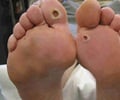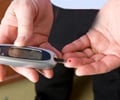
Dr. Johswich's study began with the intriguing observation that compared to wild type mice, mice deficient in the Mgat5 gene are leaner, with lower blood glucose and resistance to high calorie diets. Mice lacking the Mgat5 gene had a minimal response to glucagon which was found to be due to a requirement for the action of Mgat5 on the liver glucagon receptor. Dr. Johswich is a post-doctoral fellow in the lab of Dr. Jim Dennis at the Lunenfeld-Tanenbaum Research Institute, Mount Sinai Hospital, in Toronto, Canada.
Dr. Johswich and colleagues also found evidence for a positive feedback loop between Mgat5 and a glucose metabolism-related pathway termed the hexosamine biosynthesis pathway (HBP) that acts to amplify responses to glucagon. Mgat5 and HBP work together to increase glucagon receptor sensitivity, thereby enhancing glucose production by the liver.
In a nutrient-rich environment typical of the developed world today, carbohydrate-rich diets and positive feedback to glucagon signaling increases gluconeogenesis leading to chronic hyperglycemia, obesity, and insulin resistance.
The results suggest that selective inhibitors of Mgat5 and/or HBP may represent novel therapeutic approaches to restore normal glucose control in the setting of type 2 diabetes.
"It is extraordinary that almost a century after Banting and Best introduced insulin – and with it, the era of modern medicine – some of the world's best researchers are working on the disease just blocks from the lab where Banting and Best stood 1921," says Dr. Jim Woodgett, Director of Research at the Lunenfeld-Tanenbaum. The American Diabetes Association has named one of the paper's coauthors, Dr. Daniel J. Drucker, the 2014 awardee of the Banting Medal for Scientific Excellence, a top international honour.
Advertisement















